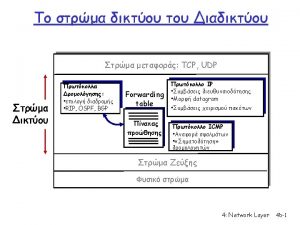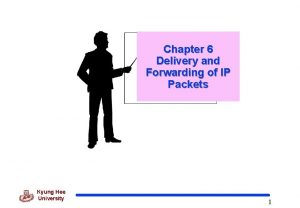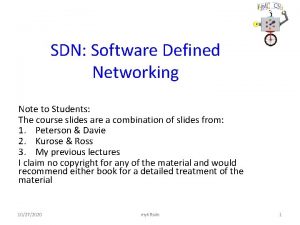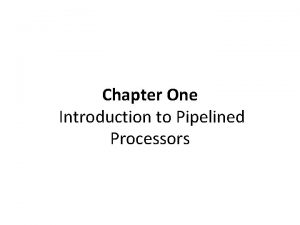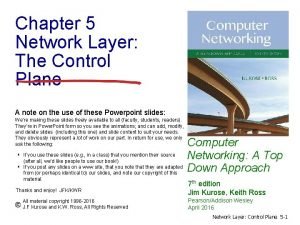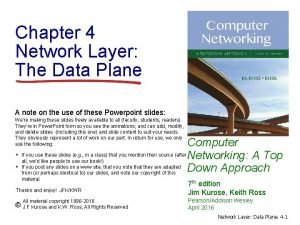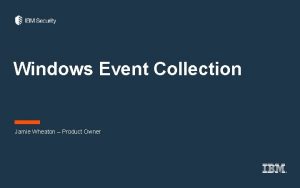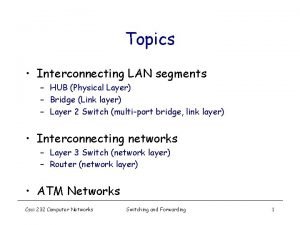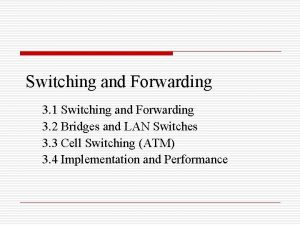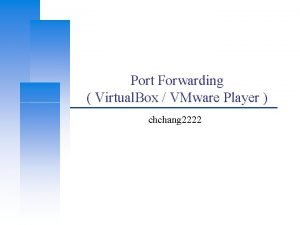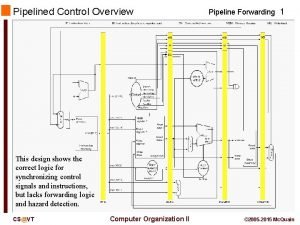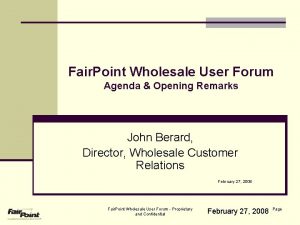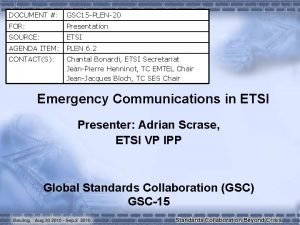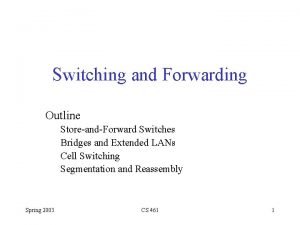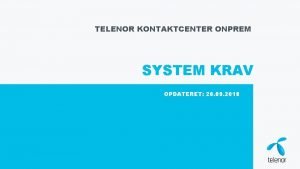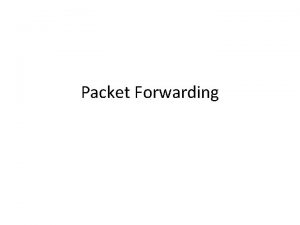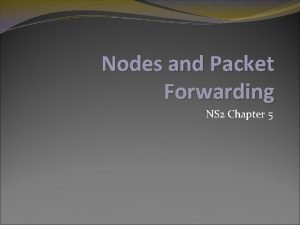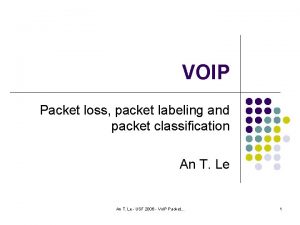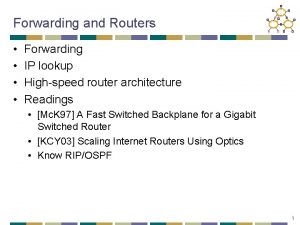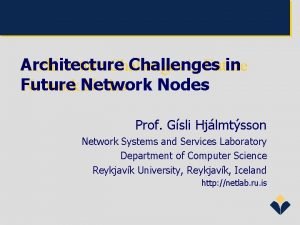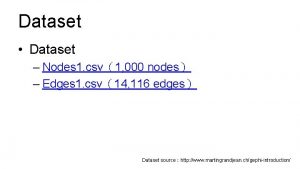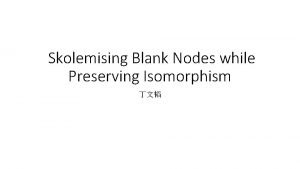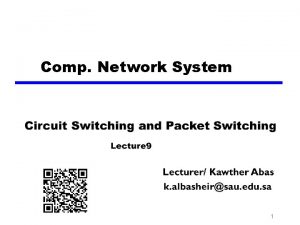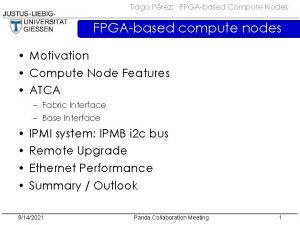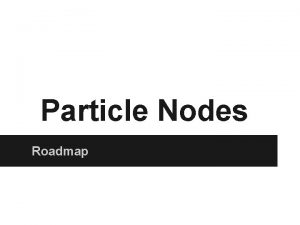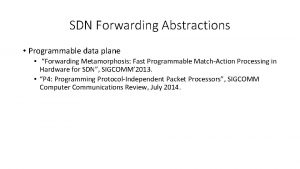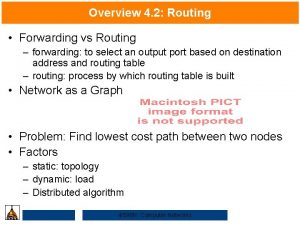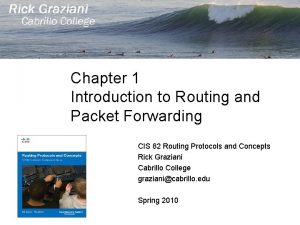Nodes and Packet Forwarding NS 2 Chapter 5








![Address & Port management $node id returns the node number $node agent [port] returns Address & Port management $node id returns the node number $node agent [port] returns](https://slidetodoc.com/presentation_image_h2/ca1326b87d0f02d91ae8fa0e0e19afbb/image-9.jpg)























- Slides: 32

Nodes and Packet Forwarding NS 2 Chapter 5

5. 1 Node Basics

Node A node is an OTcl class, but most of its components are Tcl. Objects. All node contain at least the following components ◦ ◦ ◦ An address or an id (id_) monotonically increasing by 1 (from initial value 0) A list of neighbors (neighbor_) A list of agents (agent_) A node type identifier (nodetype_) A routing module

a label variable instead of a real object Figure 5. 1 : Structure of a Unicast Node

In order to enable multicast simulation, we need to set ns [new Simulator -multicast on] Figure 5. 2 : Internal Structure of a Multicast Node

5. 2 Node methods: Configuring the Node

Node config Control functions Address and port number management, unicast routing functions Agent management Adding neighbors

Control functions $node entry is the first element which will handle packets arriving at that node $node reset will reset all agents at the node
![Address Port management node id returns the node number node agent port returns Address & Port management $node id returns the node number $node agent [port] returns](https://slidetodoc.com/presentation_image_h2/ca1326b87d0f02d91ae8fa0e0e19afbb/image-9.jpg)
Address & Port management $node id returns the node number $node agent [port] returns the handle of the agent at the specified port alloc-port returns the next available port number add-route <destination id>< Tcl. Object>and add-routes, are used by unicast routing to add routes to populate the classifier_ (Tcl. Object is the entry of dmux_) delete-routes{} takes the id, a list of Tcl. Objects, and a reference to the simulator’s nullagent

Address & Port management init-routing{} sets the instance variable multi. Path_ to be equal to the class variable of the same name intf-changed{} is invoked by the network dynamics code if a link incident on the node changes state

Agent management Procedure attach{} will add the agent to its list of agents_, [ assign a port number to the agent and set its source address, set the target of the agent to be its (i. e. , the node’s) entry{}, and add a pointer to the port demultiplexer at the node (dmux_) to the agent at the corresponding slot in the dmux_ classifier. ) ] detach{} will remove the agent from agents_

Tracking neighbors Each node keeps a list of its adjacent neighbors in its instance variable, neighbor_. Add-neighbor{} adds a neighbor Neighbors{} returns this list

5. 3 Node Configuration Interface

Node config interface Simulator: : node-config{} accommodates flexible and modular construction of different node definitions within the same base Node class ◦ $ns_ node-config -adhoc. Routing dsdv ◦ $ns_ node-config -reset The config command can be broken down into separate lines ◦ $ns_ node-config -addressing. Type hier ◦ $ns_ node-config -mac. Trace ON

Table 5. 1: Available options for node configuration

5. 4 The Classifier 5. 4. 1 Address Classifiers 5. 4. 2 5. 4. 3 5. 4. 4 5. 4. 5 Multicast Classifiers Multipath Classifier hash Classifier Replicator

Classifier When a node receives a packet, classifier examines the packet’s fields, usually its destination address, and on occasion, its source address A classifier provides a way to match a packet against some logical criteria and retrieve a reference to another simulation object based on the match results

class Classifier : public Ns. Object { public: ~Classifier(); void recv(Packet*, Handler* h = 0); protected: Classifier(); void install(int slot, Ns. Object*); void clear(int slot); virtual int command(int argc, const char*const* argv); virtual int classify(Packet *const) = 0; void alloc(int); Ns. Object** slot_; /* table that maps slot number to a Ns. Object */ int nslot_; int maxslot_; };

recv() & classify() When a classifier recv()’s a packet, it hands it to the classify() method. This is defined differently in each type of classifier derived from the base class The usual format is for the classify() method to determine and return a slot index into the table of slots

Address classifiers An address classifier is used in supporting unicast packet forwarding It applies a bitwise shift and mask operation to a packet’s destination address to produce a slot number The slot number is returned from the classify() method

Multicast classifiers The multicast classifier classifies packets according to both source and destination (group) addresses It maintains a (chained hash) table mapping source/group pairs to slot numbers

Multipath classifiers This object is devised to support equal cost multipath forwarding, where the node has multiple equal cost routes to the same destination, and would like to use all of them simultaneously This object does not look at any field in the packet. With every succeeding packet, it simply returns the next filled slot in round robin fashion

Hash classifier This object is used to classify a packet as a member of a particular flow Hash classifiers use a hash table internally to assign packets to flows

Replicator Replicator does not use the classify function Simply uses the classifier as a table of n slots; it overloads the recv() method to produce n copies of a packet, that are delivered to all n objects referenced in the table Replicator replicates a packet, one for each entry in its table, and delivers the copies to each of the nodes listed in the table. The last entry in the table gets the “original” packet

Node – Unicast vs Multicast n 0 Port Classifier Addr Classifier Node entry Unicast Node Multicast Node entry_ classifier_ dmux_ entry_ n 1 Multicast Classifier multiclassifier_

5. 5 Routing Module and Classifier Organization 5. 5. 1 Routing Module 5. 5. 2 Node Interface

NS routing function blocks Routing agent ◦ Exchange routing packet with neighbors Routing logic ◦ Uses the information gathered by routing agents (or the global topology database in the case of static routing) to perform the actual route computation Classifiers ◦ Use the computed routing table to perform packet forwarding

Figure 5. 3: Interaction among node, routing, mobile

Routing module of own Declare the C++ part of your routing module Decide which one you’ll inherit, which one you’ll override, and put the interfaces of your own module. em in OTcl

隨堂抽考 Part 1 問題 Part 2 Hint


Hint Problem 1 -- 參考/tcl/ex/simple. tcl Problem 2 -- 使用內建指令 info or Simulator instproc node-to-link {ne 1 ne 2} { ? ? return ? ? ? } Problem 3 -- 利用指令 install. Next or install 找到所要加的classifier後,使用指令去做新增動作
 Interplay between routing and forwarding
Interplay between routing and forwarding Address aggregation simplifies the forwarding process in
Address aggregation simplifies the forwarding process in Delivery and forwarding of ip packets
Delivery and forwarding of ip packets Generalized forwarding and sdn
Generalized forwarding and sdn Internal forwarding and register tagging
Internal forwarding and register tagging Generalized forwarding and sdn
Generalized forwarding and sdn Generalized forwarding and sdn
Generalized forwarding and sdn Owner
Owner Forwarding table example
Forwarding table example Forwarding table example
Forwarding table example Rcn admin portal
Rcn admin portal Forwarding portic
Forwarding portic Vmware fusion port forwarding
Vmware fusion port forwarding Forwarding equivalence classes
Forwarding equivalence classes Adobe audience manager server side forwarding
Adobe audience manager server side forwarding Hazard detection unit
Hazard detection unit Palo alto policy based forwarding
Palo alto policy based forwarding Datagram forwarding table
Datagram forwarding table Pengertian email forwarding
Pengertian email forwarding Forwarding email etiquette
Forwarding email etiquette Double data hazard
Double data hazard Forwarding state
Forwarding state Shitao li
Shitao li Fairpoint call forwarding
Fairpoint call forwarding Spectrum call forwarding
Spectrum call forwarding Forwarding table
Forwarding table App portic
App portic Dhl market outlook
Dhl market outlook Telenor office 365 support
Telenor office 365 support Protocol oblivious forwarding
Protocol oblivious forwarding Kar freight & forwarding
Kar freight & forwarding Dreamhost email forwarding to gmail
Dreamhost email forwarding to gmail I hg
I hg
